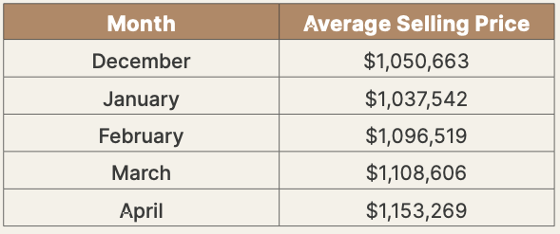As forecast in March’s Market Report, April’s residential resale market continued its upward trajectory for the third month in a row. Sales volumes increased by more than 9 percent compared to March and the average sale price, which also bounced for the third month in a row since January, increased by more than 3 percent compared to March.

This trajectory is unlikely to change in May. It would have been even steeper if not constrained by affordability and the alarming decline in supply.
Although April’s 7,531 residential sales were 5.2 percent less than the 7,940 sales achieved last year, they reflect growing buyer confidence and acceptance that the exceptionally low financing costs enjoyed during the pandemic are a thing of the past. Demand has not abated, pushed to extraordinarily high levels by growth in population in the greater Toronto region, driven years of high levels of immigration. Between the years 2018 and 2022, more than 600,000 immigrants have moved into southern Ontario. New housing supply has not kept pace with this growth in population.
As a result of the eye-popping demand, average sale prices continue to rise in April, even in the face of high mortgage financing costs and borrower stress testing which adds 2 percent to the interest rate at which borrowers are attempting to qualify. April’s average sale price of $1,153,269 was only 7.8 percent lower than the average sale price achieved in April 2022. When interest rates begin to decline, which is expected in 2024, we could see average sale prices increasing to the stratospheric heights achieved during the pandemic. Six months ago this possibility was inconceivable.

The number of new properties coming to market became even more troubling during April. In April only 11,364 new listings became available to the many buyers waiting to buy. This is a 38 percent decline compared to the 18,416 properties that came to market last April. More troubling is the available supply as April came to an end. At the end of April, there were only 10,373 active listings, more than 20 percent less than the 13,092 properties available to buyers at the end of April last year. April marked the first month since March of last year when active listings were fewer than the corresponding month the year before.
Given the demand and the lack of supply in the greater Toronto area, it is not surprising that all available properties (on average) sold in only 17 days. The speed at which properties sold in April is quickly approaching the speed with which properties in the greater Toronto area sold during the height of the pandemic market – 8 days! All properties in the City of Toronto sold in only 18 days (slightly slower due to the preponderance of condominium apartment sales) but incredibly for 103 percent of their asking prices. In Toronto’s eastern districts all properties, condominium apartments, detached and semi-detached properties sold in only 11 days and for an eye-popping 109 percent of their asking prices. Semi-detached properties in the eastern districts sold in only 8 days at 115 percent of their asking prices. The average sale price of semi-detached properties in Toronto’s eastern districts was $1,223,687. Across all of Toronto the average sale price for semi-detached was $1,326,462. Detached properties came in at $1,787,752.
Shockingly there were seven eastern districts that reported less than five semi-detached property sales – simply because there was no supply!
Fast sales and sale prices exceeding asking prices were not restricted to the City of Toronto. All property sales in Halton, York, and Durham region sold well above their asking prices, 101, 105, and 107 percent above asking, respectively, with all properties selling (on average) after only 15 days on the market.
The Toronto and region residential resale market is quickly moving towards crisis levels. Governments now have no one to blame but themselves, and hopefully are beginning to accept that the housing crisis can not be improved by restrictive legislation. At the federal level, there is a prohibition on foreign buyers purchasing residential properties in Canada. At the provincial level, there is a 25 percent (of the purchase price) tax on foreign buyers. At the municipal level (City of Toronto) there is a 1 percent vacancy tax. None of these legislative actions have addressed Toronto and the region’s housing issues. Toronto’s resale market is driven by domestic demand, as numerous studies have demonstrated. Population growth, which is expected to continue, requires appropriate levels of new housing, which have not been forthcoming. It is safe to forecast that the residential resale conditions that have clearly manifested themselves in April will continue and intensify as we move towards the second half of 2023.



Comments:
Post Your Comment: